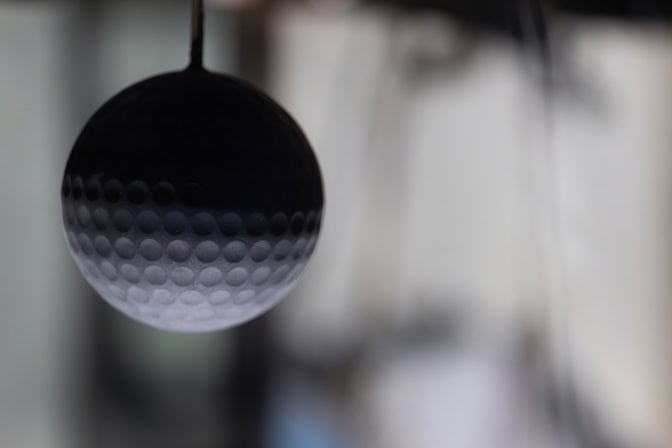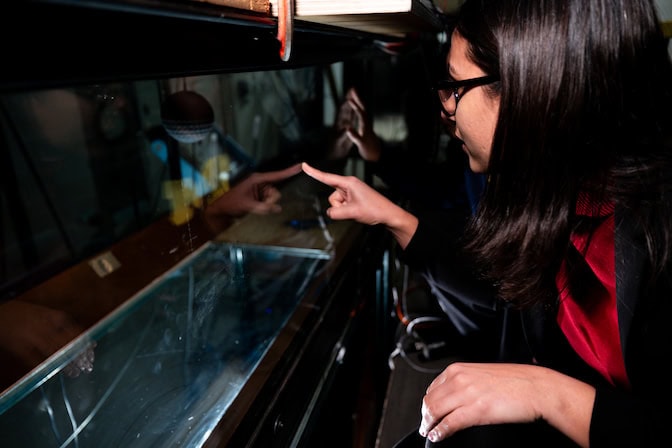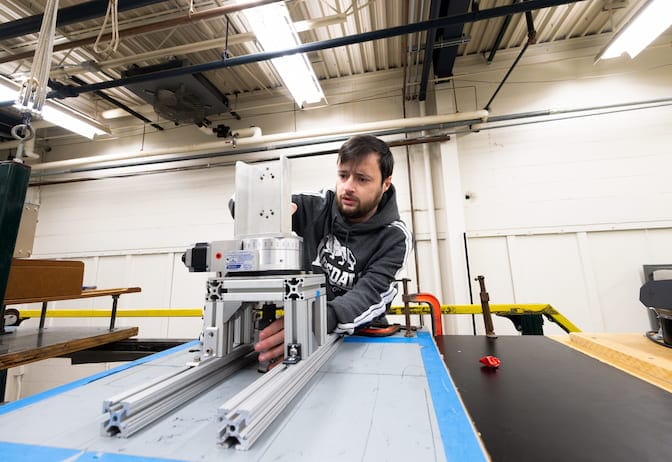
Maneuverable underwater vehicles inspired by golf balls
A spherical prototype with nimble dimples can change its surface from smooth to dimpled, cutting through drag and generating lift.

A spherical prototype with nimble dimples can change its surface from smooth to dimpled, cutting through drag and generating lift.
Experts

Assistant Professor of Naval Architecture and Marine Engineering and Mechanical Engineering
Underwater or aerial vehicles with dimples like golf balls could be more efficient and maneuverable, a new prototype developed at the University of Michigan has demonstrated.
Golf ball dimples cut through pressure drag—the resistance force an object meets when moving through a fluid—propelling the ball 30% further than a smooth ball on average. Taking this as inspiration, a research team developed a spherical prototype with adjustable surface dimples and tested its aerodynamics in a controlled wind tunnel.
“A dynamically programmable outer skin on an underwater vehicle could drastically reduce drag while eliminating the need for protruding appendages like fins or rudders for maneuvering. By actively adjusting its surface texture, the vehicle could achieve precise maneuverability with enhanced efficiency and control,” said Anchal Sareen, an assistant professor of naval architecture and marine engineering and mechanical engineering at U-M and corresponding author of two studies published in Flow and The Physics of Fluids.
Anchal: The way I envision it, you would have an underwater vehicle where the outer skin is dynamically programmable. That would not only help you with reducing drag, but would also allow you to get rid of all those protruding appendages and allow the vehicle to move on demand by just changing the surface texture.
Anchal: Underwater or aerial vehicles, they have a lot of drag penalty and that reduces their fuel efficiency. Increases the carbon emission. So a lot of effort is there to reduce the drag on these vehicles. The sphere idea came because we had an undergrad student who wanted to work on a golf ball aerodynamic problem, and we know that if you add dimples on a golf ball, it can go 30% farther than a smooth ball. And as it turns out, if you want to reduce drag on a golf ball, you need a different dimple depth at different flow velocity. And then we came up with this idea: how about we can dynamically change dimple depth with the changing flow velocity, so that it doesn’t matter what the flow velocity is — we’re always minimizing drag.
Nanda: Ok.
Rodrigo: So in this study we have to come up with an adaptive skin on the sphere, which is able to notice the incoming velocity of the flow, adjust the dimples accordingly, and also it’s able to notice velocity changes. We believe that we can apply this concept to underwater vehicles and maximize the performance of those vehicles by reducing the drag, which will lead to less fuel consumption, and also by creating lift, which will improve the maneuverability of the vehicles.
Nanda: Derived from the data that we have. So we first capture all the data and we draft this equation…
Anchal: One very interesting thing we found was without rotation, just with surface morphing, we can generate as much lift as you would generate by rotating the bluff body. So if you want to go, let’s say, right, you will actuate dimples on this side, and then this vehicle will go right. And if you want to go left, you will actuate dimples on this side and it can go left. This is the first time, especially in our group, that we have developed soft robotic capabilities and we combined it with experimental fluid dynamics. And I’m looking forward to collaborations where we can bring in expertise in material science as well as soft robotics, and merge them with fluid dynamics to do some very exciting, state-of-the-art research.
These nimble vehicles could access typically hard-to-reach areas in the ocean while conducting surveillance, mapping new areas or collecting data on water conditions.
The researchers formed the prototype by stretching a thin layer of latex over a hollow sphere dotted with holes, resembling a pickleball. A vacuum pump depressurizes the core, pulling the latex inwards to create precise dimples when switched on. Turning off the pump makes the sphere smooth again.

To find out how the dimples affected drag, the sphere was put to the test within a three meter long wind tunnel, suspended by a thin rod and subjected to different wind velocities.
For each flow condition, the dimple depth could be finely adjusted by shifting the vacuum pump’s strength. Drag was measured using a load cell, a sensor that detects force exerted by airflow on the object. At the same time, an aerosol was sprayed into the wind tunnel while a high-speed laser and camera captured the motion of the tiny particles as they flowed around the sphere.
For high wind speeds, shallower dimples cut the drag more effectively while deeper dimples were more efficient at lower wind speeds. By adjusting dimple depth, the sphere reduced drag by 50% compared to a smooth counterpart for all conditions.
“The adaptive skin setup is able to notice changes in the speed of the incoming air and adjust dimples accordingly to maintain drag reductions. Applying this concept to underwater vehicles would reduce both drag and fuel consumption,” said Rodrigo Vilumbrales-Garcia, a postdoctoral research fellow of naval architecture and marine engineering at U-M and contributing author to the studies.

The smart morphable sphere can also generate lift, allowing for controlled movement. Often thought of as the upwards force responsible for keeping planes in the air, lift can work in any direction as long as it is perpendicular to the direction of the flow.
To achieve this, researchers designed the inner skeleton with holes on only one side, causing the sphere to develop one smooth and one dimpled side when activated.
This created asymmetric flow separation on the two sides of the sphere, deflecting the wake toward the smooth side. By Newton’s third law, the fluid applies an equal and opposite force toward the rough side, effectively pushing the sphere in the direction of the dimples. Dimples on the right generate force to the right while those on the left push left. This enables precise steering by selectively activating dimples on the desired side.
The team tested the new sphere in the same wind tunnel setup with varying wind velocity and dimple depth. With the optimal dimple depth, the half rough/half smooth sphere generated lift forces up to 80% of the drag force. The lift generation was as strong as the Magnus effect, but instead of using rotation, it was created entirely by modifying the surface texture.
“I was surprised that such a simple approach could produce results comparable to the Magnus efect, which requires continuous rotation,” said Putu Brahmanda Sudarsana, a graduate student of mechanical engineering at U-M and contributing author to the studies.
“In the long run, this could benefit, for example, compact spherical robotic submarines that prioritize maneuverability over speed for exploration and inspection. Typically, these submarines would require multiple propulsion systems, but this mechanism could help reduce that need,” added Sudarsana.

Looking ahead, Sareen anticipates exciting collaborations that combine expertise in materials science and soft robotics, further advancing the capabilities of this dynamic skin technology.
“This smart dynamic skin technology could be a game-changer for unmanned aerial and underwater vehicles, offering a lightweight, energy-efficient, and highly responsive alternative to traditional jointed control surfaces. By enabling real-time adaptation to changing flow conditions, this innovation promises to enhance maneuverability, optimize performance, and unlock new possibilities for vehicle design,” added Sareen.